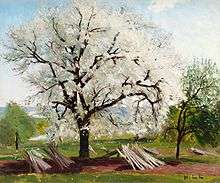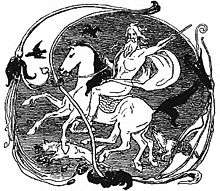_by_Erling_Mandelmann.jpg)
photo of Asger Jorn, 1963, photographer by Erling Mandelmann; - quote of Jorn, 1941: 'We are not disillusioned because we have no illusions; we have never had any. What we have, and what constitutes our strength, is our joy in life, in all of its moral and amoral manifestations'
Asger Oluf Jorn (March 3, 1914 – May 1, 1973) was born in Vejrum, in the northwest corner of Jutland, Denmark and baptized Asger Oluf Jørgensen. In 1946 he changed his name into Asger Oluf Jorn. He was a founding member of the COBRA-group and later of the Situationist International; he was a prolific artist, active organizer and essayist. He felt himself strongly connected to Nordic myths, as well as to modern times.
Quotes of Asger Jorn
- sorted chronologically, after date of the quotes of Asger Jorn

photo of the cover of Jorn's publication, 1960: 'Open Creation and it Enemies'; - quote of Asger Jorn, 1945: 'We are not talking about a new cognition in relation to abstract art, rather a new area of cognition'

photo of Jorn's telegram to Mr. Guggenheim, 1964', rejecting the offered reward: 'GO TO HELL BASTARD STOP. REFUSE PRIZE STOP. NEVER ASKED FOR IT STOP. AGAINST ALL DECENCY MIX ARTIST AGAINST HIS WILL IN YOUR PUBLICITY STOP. I WANT PUBLIC CONFIRMATION NOT TO HAVE PARTICIPATED IN YOUR RIDICULOUS GAME.'
1940 - 1948
'Intimate Banalities' (1941)
- Quotes of Jawlensky, from: 'Intime Banaliteter', in Helhesten 1 (1941), p. 75 - 79

The great work of art is the complete banality, and the fault with most banalities is that they are not banal enough.

Those who try to combat the production of shoddy pictures are enemies of the best art today.

It always feels tragic to see people labouring to saw off the branch they are sitting on.

The artist’s interest cannot be restricted to a single field; he must seek the highest perception of everything, of the whole and its details.
- The great work of art is the complete banality, and the fault with most banalities is that they are not banal enough. Banality here is not infinite in its depth and consequence, but rests on a foundation of spirituality and aesthetics.
- There is also, for instance, a direct symbolic strength in the words 'Say it with flowers', which makes that poem one of the cornerstones of Danish lyricism. It has stood out like a boot of an exceptionally fine fit..
- Those who try to combat the production of shoddy pictures are enemies of the best art today. Those woodland lakes in a thousand sitting-rooms with gold-tinted wallpaper belong to the profoundest inspirations of art. It always feels tragic to see people labouring to saw off the branch they are sitting on.
- There can be no question of selecting in any direction, but of a penetrating the whole cosmic law of rhythms, forces and material that are the real world, from the ugliest to the most beautiful, everything that has character and expression, from the crudest and most brutal to the gentlest and most delicate; everything that speaks to us in its capacity as life. From this it follows that one must know all in order to be able to express all. It is the abolition of the aesthetic principle. We are not disillusioned because we have no illusions; we have never had any. What we have and what is our strength, is our joy in life; our interest in life, in all its amoral aspects. That is also the basis of our contemporary art. We do not even know the laws of aesthetics. That old idea of selection according to the beauty-principle Beautiful — Ugly, like to ethical Noble — Sinful, is dead for us, for whom the beautiful is also ugly and everything ugly is endowed with beauty. Behind the comedy and the tragedy we find only life's dramas uniting both; not in noble heroes and false villains, but people.
- Variant translations:
- What we possess and what gives us strength is our joy in life, our interest in life in all its amoral facets. This is also the foundation for today's art. We do not even know the aesthetic laws.
- We are not disillusioned because we have no illusions; we have never had any. What we have, and what constitutes our strength, is our joy in life, in all of its moral and amoral manifestations.
- The reckoning with idealism as a view of life is universal, but it also touches on something central in art-its life's substance. One must understand that it is impossible to distinguish between a picture’s form and its substance. As the flower's structure is governed by the intentional tension (when it loses the sap the form is lost), so also with art the substance creates the tension. Form and substance are one and the same. Form is the life expression and substance the living painting.
- The picture's substance reflects the painter's substance, showing how much he has felt of himself and his society, how much he spans and how deep his experience goes.
- We cannot inherit a fixed, unmoving view of life and of art from the past generation. The expression of art is in any period different, as are our experiences. A new experience creates a new form. We like to learn all we need from earlier generations, but we have to find out for ourselves what we need; nobody else can do that for us. It is not our business to receive and work on what the earlier generation might want us to work on. On the other hand, it is its business to help us where we want its help.
- If one tries to understand the position of art today, one must also try to understand the conditions that have created the development of our perception of art and our perception of the relation to the individual and to society. The artist takes an active part in the campaign to deepen this our knowledge of the basis of our existence, the basis which, for him, makes possible an artistic creation. The artist's interest cannot be restricted to a single field; he must seek the highest perception of everything, of the whole and its details. Nothing can be sacred to him, because everything has become important to him.
Various sources
- Beautiful, ugly, impressive, disgusting, meaningless, grim, contradictory etc.. .It makes no difference, as long as it is life, vigorously pouring forth.
- Quote from: Ansigt til Ansigt [Face to Face], A-5, 1 (1944), p. 14
- If the image was sketched onto the canvas and spontaneously drawn, colour would often be restrained and unfree.. .The most important and the most difficult liberation process we went trough, the one that has distinguished our art, was the freeing of colour, the transition to a painterly spontaneity.
- Statement (c. 1944), on automatic drawing, quoted in Asger Jorn (2002) by Arken Museum of Modern Art, p. 162
- We are not talking about a new cognition in relation to Abstract art, rather a new area of cognition.. .This is where abstract art steps in, in a stronger sense of life, a stronger contact with the growing life, a feeling of the pulsation of life and growth in oneself, an activation of deep-seated powers a staple vitality far deeper than our cognition, not instead of science but inspired by it.
- Quote by Jorn, after Egill Jacobson's exhibition in Kunstforeningen (1945)
- [My own goal is] to be completely empty of ideas at the moment of setting brush to canvas, the head being just as empty as the canvas.
- In a conversation with Pierre Loeb, circa 1946; as quoted on the website of the Jorn Museum 'Articles' by Jorn
- It seems to me that today the Surrealist crisis is the central problem in French art. It is essential for future development that this crisis should be solved... The principal error in the aesthetic program of Surrealism is that it is too literary. Painters have experimented with visions, images, dreams, but not with painting, not with color.. .The unpainterliness of Surrealism has inevitably produced a reaction among younger painters. [Jorn is thinking here of French painters such as Bazaine, Esteve, Lapique, Singier, Le Moal, and he suggests there should be reciprocity].. .These artists cannot get any further unless they absorb the lessons of Surrealism into their painting, just as Surrealists can only advance if they adopt the painterly methods of the other group.
- Quote in a writing of Jorn on modern art in Paris, 1947; as cited on the website of the Jorn Museum. 'Articles' by Jorn
1949 - 1958
'Speech to the Penguins' (1949)
- Quotes of Asger Jorn, from: 'Discours aux pingouins' [Speech to the Penguins], Cobra 1 (1949)
- The act of expressing oneself is a physical one. It materializes the thought.
- Breton's Surrealists wanted to place themselves outside. What is it what they want to put outside? Pure thought. That is, the only metaphysical world, reflection. But from a materialistic standpoint thought is a reflection of matter — as in a mirror. The metaphysical world is not able to surmount the material world which produces it. One has to think of SOMETHING. But for thought to be dialectical, it's object / it's "thing" must cease to be attached to everyday life.
- The basic function of thought is to find ways of satisfying our needs and desires. The Surrealism of Breton and the functionalism of architecture which was more concerned with the way in which thought functions rather than with its function, — was initially idealistic. But is this not something which we can extract from Breton’s definition of automatism?
- Our experiments [the artists of 'Cobra'] the aim at letting thought express itself spontaneously without the control which reason represents. By means of this irrational spontaneity we get closer tot the vital source of life. Our goal is to liberate ourselves from the control of reason which has been and still is the thing which the bourgeoisie has idealized to seize control of life.
- In contrast to Breton we believe that — behind the false ethical and aesthetic, indeed metaphysical understandings which are out of contact with the vital interest of "man" — we find the real, the materialistic ethics and aesthetics. One includes our needs, the other is an expression of our sensual desires. It is exactly in order to liberate the true ethics and the true aesthetics that we make use of "automatism."
- The law of aesthetics is the same as the law for our desire… Need says: "You must eat." Aesthetics says: "You can do it in a thousand different ways." Ethics: "You need a woman." Aesthetics: "Which woman do you want?" Thus the purpose of art is first and foremost ethical than aesthetic — even when the wish becomes need. The goal changes from the general to the individual from need to wish, from ethics to aesthetics.
- Even here, nothing ever happens; and nothing ever happens to it.
Various sources
- An example of this way of thinking is an exchange that took place when someone told Goethe that he admired him for his genius, towering over German intellectual life like a gigantic mountain, to which Goethe replied that "great mountains are found only in mountainous landscapes." The traditional history of art is concerned exclusively which such mountain peaks, and often, as Goethe critically pointed out, they are not even seen in relation to each other.
- Jorn's quote, on the publication of the book Thidrek of Folk Art (1948)
- This is not an objective, historical or psychological evaluation of Danish experimental art and its historical roots, but an ideological and artistic, collective representation of our own work, thoughts, and ideas. It shows how we ourselves view our work and our way of working, and considers which of the many traditions that make up our foundation we feel connected to.
- from Jorn's 'Notebook', containing the draft for a book on Danish experimental art (1948)
- You can often give a better description of the fight between people, the essentials of it, by means of fantastic animals, the simple, primitive, naked instincts, than by depicting a specific situation. It is not the human animal we should describe, but ourselves as human animals.
- Statement in 1950, as quoted in Asger Jorn (2002) by Arken Museum of Modern Art, p. 76
- Everything is in constant flux, from state to state, from good to bad and back again.. ..only in transmutation, perpetual motion, lies truth.
- Statement in 1950 on reality as motion, as quoted in Asger Jorn (2002) by Arken Museum of Modern Art
- We are sparks that must glow as brightly as possible.
- On being an pictorial artist (1950), as quoted in Asger Jorn (2002) by Arken Museum of Modern Art, p. 5
- One day Pierre Loeb said to me that the ideal picture is one which is completely clear in the artist's mind before he puts a mark on the canvas, and this was, at any rate in this period.. ..Léger's opinion. It is the basis on which classical art is built. Therefore the setting-down of the picture on the canvas is in itself something quite unimportant. This is connected with [Fernand] Léger's hatred of textural effects in painting. But I love these effects. I remember that I was once told off because I had applied a thick layer of color instead of the thin and even layer that Léger wanted. To him that was not painting but mere color. If he could have got a machine instead of a brush to apply the color, he would have done so.
- Quote in Jorn's letter, 1952; as cited on the website of the Jorn Museum 'Articles' by Jorn
- his critical comment on the art teachings of Fernand Léger, which Jorn started to follow circa 1936, in Paris.
- This calls for an explanation and it may be this, that no painting, however good it seems to us is anything in itself, except chemicals smeared on a flat surface. The value in the work of art is in the spectator, you see, and a painting has no bigger value than the mental and intellectual forces it arouses in the spectator.
- Jorn's quote, from his speech at the library of Silkeborg, September l0th 1953 (translated from an unpublished Danish manuscript by Guy Atkins) ; as quoted on the website of the Jorn Museum Articles by Jorn
- When I used [in his speech] the word silent myths it was for a personal reason. I mean that the relations of pictorial art to the formation of myths has to be silent, consequently not illustrative. In this part of Jutland where the life of the myth has grown strongest and is kept deepest for millenniums, here where I come from and where I have known the richness of the narrative imagination of the people, here I wanted to place a monument to the anonymous strength of the word, not to a single myth, nor to a single cycle of myths, because the myths of the Edda, of the heroic poetry, yes perhaps particularly the myths of the Kalevala, have inspired me like the myth which is to be created today in the people who are glad to tell, racy and fertile.
- Quote from Jorn's speech at the library of Silkeborg, September l0th 1953 (translated from an unpublished Danish manuscript by Guy Atkins) ; as quoted on the website of the Jorn Museum Articles by Jorn
1959 - 1973

The goal changes from the general to the individual from need to wish, from ethics to aesthetics.

Beautiful, ugly, impressive, disgusting, meaningless, grim, contradictory etc.. .It makes no difference, as long as it is life, vigorously pouring forth.

This is what aesthetics, development and progress depend upon: that we go out on thin ice.

We are sparks that must glow as brightly as possible.

Being an artist is being an isolated individual. … Paths cross and the soil of time is starting to be turned.

I act with full responsibility and after extensive reflection.
Various sources
- This is what aesthetics, development and progress depend upon: that we go out on thin ice.
- On the task of modern artists (1959), as quoted in Asger Jorn (2002) by Arken Museum of Modern Art, p. 169
- Be modern
collectors, museums
if you have old paintings
do not despair
Retain your memories
but detourn them
so that they correspond with your era.
Why reject the old
if one can modernize it
with a few strokes of the brush.
This casts a bit of contemporaneity
on your old culture.
Be up to date
and distinguished
at the same time.
Painting is over
You might as well finish it off
Detourn (détournez)
Long live painting.- On his Détournements, modifications of old, existing paintings, in the foreword to the catalogue of his exhibition Modifications (1959)
- It has been the giver's intention to create as complete a collection of European art as possible, with the aim of illuminating Surrealism and Spontaneous-Abstract art.
- refering to his art-gift Jorn made the Mmseum Jorn (1962); as quoted in Silkeborg Kunstmuseum — Jorn Samling by Troels Andersen (1973)
- We have defined art as the life form and aesthetic art as the life renewal: the stimulating, animating, agitating, inspiring, inspirational, fermenting, fascinating fanaticising, explosive and outrageous: the renewal of the unknown.
- Statement of 1963, as quoted in Asger Jorn (2002) by Arken Museum of Modern Art, p. 52
- To break and be able to grow together again in a better way: that is the difficult art.
- Statement of 1963, as quoted in Asger Jorn (2002) by Arken Museum of Modern Art
- To get anywhere, one must choose one's mistakes, I chose experimental acts. (1963)
- Statement of 1963, as quoted in Asger Jorn (2002) by Arken Museum of Modern Art, p. 129
- It is said that my art has some typically Nordic features: the curving lines, the convolutions, the magical masks and staring eyes that appear in myths and folk art. This may be. My interest in the dynamics of Jugend style probably also comes into it.
- Quote of Jorn, from: Tecken för liv, tecken till liv [Signs of life, the characters to life], interview by Marita Lindgren-Fridell, in Konstrevy (1963)
- In the beginning was the image.
- Title of one of his paintings (1965)
- If you add something to a painting, never let it be for aesthetic reasons. Only let it be for reasons of expression.
- Statement to his friend Pierre Alechinsky, between 1965-1970; as quoted in Asger Jorn (2002) by Arken Museum of Modern Art, p. 115
- Being an artist is being an isolated individual. But the development of the creative foundation of the encumbers the individual artists more and more with the prevailing problems. You are of your time whether you like it or not. Developing ones foundation to an artist means continually revising it. The artistic formulae wear thin quickly and yet daily the artist — when developing his own foundation — must enter his own time and the problems of other contemporary artists. Paths cross and the soil of time is starting to be turned.
- Quote in the late 1960s, as cited in Asger Jorn (2002) by Arken Museum of Modern Art, p. 28
- My work is based on a tradition quite distinct from the Eckersberg tradition, a Nordic line of development that had never been clearly and consistently defined in the literature on art. This line is not a straight one; it has the strangest and most fascinating twists and curves, and includes such artists as Edvard Munch, Ernest Josephson, Hill, Hansen Jacobsen, Johannes Holbek, Jens Lund, and Emile Nolde. Not all of them equally well known.
- Statement in the late 1960s, as quoted in Fortaelleren Asger Jorn (1984) by Gunnar Jespersen, p. 121
- GO TO HELL BASTARD STOP. REFUSE PRIZE STOP. NEVER ASKED FOR IT STOP. AGAINST ALL DECENCY MIX ARTIST AGAINST HIS WILL IN YOUR PUBLICITY STOP. I WANT PUBLIC CONFIRMATION NOT TO HAVE PARTICIPATED IN YOUR RIDICULOUS GAME.
- Quote from Wikipedia: the text of Asger Jorn's telegram in 1964, to the president of the Guggenheim Museum, Harry F. Guggenheim
- Jorn was awarded a Guggenheim Award including a generous cash prize, by an international jury assembled by Lawrence Alloway; he rejected!
- The reverse process is extremely important to me — that artistic images can inspire to words and different myths, and that in certain cultures this process has been the normal relation between images and words. It is known as a rule in the so-called Germanic art, and through the middle ages heaps of such stories are directly inspired by fantastic images.
- Quote in Jorn's letter to anthropologist Francis Huxley (1970) - on the relation between words and images
- To understand the magic way of thinking you have to know non-magic thinking. If you see that clearly, you will see how many magic thoughts are necessary elements even of natural science today. There seems to be just as much magic thinking in modern thought as in older; only it takes place in other areas.
- Quote in Jorn's letter to anthropologist Francis Huxley (1970) - on the magical character of thinking and images
- To make the material speak to man in the name of man, this is the aim and reality of art.
- Statement of 1971; as quoted in Asger Jorn (2002) by Arken Museum of Modern Art, p. 145
- True realism, materialist realism lies in the search for the expression of forms faithful to their content. But there is no content detached from human interest.
- As quoted in Aftermath France, 1945-54: New Images of Man: An Exhibition (1982), p. 107
- In 1939 I wrote my first article ('Intime banaliteter' [Intimate banalities] in the journal Helhesten) in which I expressed my love for sofa painting, and for the last twenty years I have been preoccupied with the idea of rendering homage to it. Thus I act with full responsibility and after extensive reflection. Only my current situation has enabled me to accomplish the expensive task of demonstrating that the preferred sustenance of painting is painting.
- Quote of Jorn, in On the Passage of a few people through a rather brief moment in time: the Situationist International, 1957-1972 (1989), edited by Elisabeth Sussman, p. 142
- If a symbolic language dies, it tortures us like a nightmare, like a thousand piece orchestra grating on our nerves and tearing our mind to pieces.. .It is a corpse with no symbolic power or strength.
- quoted in Asger Jorn (2002) by Arken Museum of Modern Art, p. 166
- Jorn is talking about symbolism of the Nordic myths
'Alpha and Omega', (1963–64)
- Quotes from: Jorn's posthumous published work Alpha and Omega, København 1963–64
- l don't know what Nordic art is worth in other people's minds.. ..but in today's cosmopolitan art world it doesn't figure at all.. .Nordic art is dangerous. It compresses all its power inside ourselves. It is not a hedonistic or sensuous art. It neither claims to be objectively intelligible, nor does it deal in clear and conscious symbols. The Danish author Jakob Knudsen hit on something important when he said that Nordic art has mood and works on the mood more than on the senses or the understanding..
- as quoted on the website of the Jorn Museum 'Articles' by Jorn
- Nordic art casts a spell on the mind which ranges from laughter to tears and from tears to violent rage. One can see how dangerous it is, we can be tyrannized by a cynical person endowed with the power of art. Much has been said about this demonic aspect. In it lies the ultimate demand that the artist must take responsibility for the states of mind that he produces, or at least he must answer for them by knowing them in his own person. This psychic demand in both the artist and the viewer has made Expressionist art so hated by devotees of aestheticism and formalism.
- as quoted on the website of the Jorn Museum 'Articles' by Jorn - Jorn talks about the Nordic concept of Expressionism
Quotes about Asger Jorn
- sorted chronologically, after date of the quotes about Asger Jorn
- Jorn's role in the Situationist movement (as in COBRA) was that of a catalyst and team leader. Guy Debord on his own lacked the personal warmth and persuasiveness to draw people of different nationalities and talents into an active working partnership. As a prototype Marxist intellectual Debord needed an ally who could patch up the petty egoisms and squabbles of the members. Their quarrels came into the open the moment Jorn's leadership was withdrawn in 1961.. .Finally, 1966-8 saw the vindication of Debord's policy, sustained against every kind of opposition, of adhering rigidly to the uncompromising pursuit of a single-minded plan. When the time came - in Strasbourg in November 1966 and in Paris in May 1968 - Debord was ready, with his two or three remaining supporters, to take over the revolutionary role for which he had been preparing during the last ten years. Incredible as it may seem, the active ideologists ('enragés' and Situationists) behind the revolutionary events in Strasbourg, Nanterre and Paris, numbered only about ten persons.
- Quote of Guy Atkins, Troels Andersen (1977) Asger Jorn, the crucial years 1954-1964, p. 63
- One method [of Jorn] was to work with accidental shapes, and this was to become a lifelong preoccupation. But in the beginning the techniques of Surrealism were put to good use: Collage, frottage, color sprayed on paper with an airbrush or floated on the surface of a bowl of water and lifted off on paper. Another way to break the link between line and plane was by what Arp called the "square-eyed" method or alternately, with Dali, putting one drawing on top of another, using transparent paper. Jorn had availed himself of all these methods and experiments by 1940.
- Quote of Troels Andersen (1985), in Asger Jorn, Silkeborg Kunstmuseum, (translated from Danish by Peter Shiled) pp. 25-31
External links
This article is issued from
Wikiquote.
The text is licensed under Creative
Commons - Attribution - Sharealike.
Additional terms may apply for the media files.

